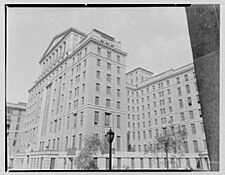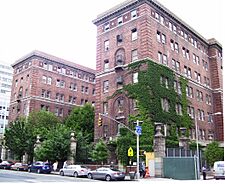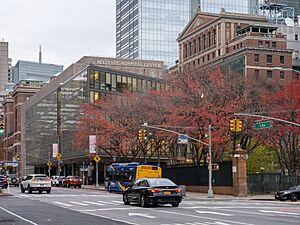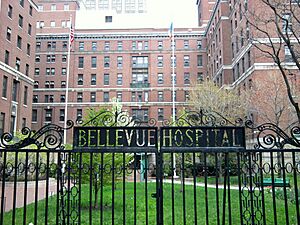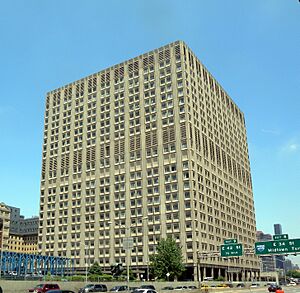Bellevue Hospital facts for kids
Quick facts for kids Bellevue Hospital |
|
|---|---|
| NYC Health + Hospitals | |
| Geography | |
| Location | 462 First Avenue, Manhattan, New York, New York, United States |
| Coordinates | 40°44′21″N 73°58′31″W / 40.7393°N 73.9753°W |
| Organization | |
| Funding | Public hospital |
| Hospital type | Teaching |
| Affiliated university | New York University School of Medicine |
| Network | NYC Health + Hospitals NYU Langone Health System |
| Services | |
| Emergency department | Level I Adult Trauma Center / Level II Pediatric Trauma Center |
| Helipad | East 34th Street Heliport (IATA: TSS) |
| Beds | 912 |
| History | |
| Founded | March 31, 1736 |
Bellevue Hospital is a famous hospital in New York City. It is the oldest public hospital in the United States, which means it is run by the government to serve everyone. It is also one of the largest hospitals in the country. You can find it at 462 First Avenue in the Kips Bay neighborhood of Manhattan.
For a long time, Bellevue was well-known for its care of patients with mental health challenges. Because of this, the name "Bellevue" was sometimes used as slang for a psychiatric hospital. Today, Bellevue is a huge medical center that offers many kinds of care. This includes regular check-ups, special treatments, and emergency services. The hospital has a 25-story building for patients, with 1,200 doctors and about 5,500 other staff members.
Bellevue is a safety net hospital. This means it provides healthcare to people even if they don't have insurance or can't afford to pay. The hospital helps over half a million patients every single year.
Contents
History of Bellevue
How It All Started
Bellevue began in 1736 as the city's first almshouse. An almshouse was a place that cared for the poor and sick. It was a simple two-story brick building located where City Hall Park is today.
In 1798, the city bought a farm called "Belle Vue." This land was used to care for people who were sick with yellow fever. The hospital was officially named Bellevue Hospital in 1824.
Starting in 1787, doctors and medical students from Columbia University began working at Bellevue. Later, in 1819, New York University also started sending its teachers and students to train there. In 1861, the Bellevue Hospital Medical College opened. It was the first medical school in New York that was directly connected to a hospital.
A Place of Many Firsts
Bellevue became a leader in healthcare. In 1873, it opened the first nursing school in the country based on the ideas of Florence Nightingale. A year later, it opened the first clinic just for children. In 1879, it built a special building for patients with mental illness, which was a new and kind approach at the time.
The hospital also created a training program for surgeons in 1883 that is still used all over the world. In 1884, it opened the Carnegie Laboratory, the first lab in the U.S. for studying diseases.
Growing with the City
In the early 1900s, Bellevue continued to grow. During a tuberculosis outbreak, it opened the Bellevue Chest Service to help sick patients. In 1911, it opened the first heart clinic where patients could walk in for treatment.
In 1919, a German spy named Fritz Joubert Duquesne famously escaped from the hospital's prison ward. He had pretended to be paralyzed for almost two years!
In 1939, the world's first hospital disaster unit was created at Bellevue. This special team was ready to help in major emergencies. A few years later, in 1964, Bellevue was chosen as the official hospital for visiting presidents and other important leaders.
In October 2012, Hurricane Sandy caused a major power outage and flooding at the hospital. All patients had to be safely moved to other hospitals. In 2015, the hospital was renamed NYC Health + Hospitals/Bellevue to show it is part of the city's larger health system.
Amazing Medical Achievements
Bellevue has a long history of medical breakthroughs. Here are just a few:
- 1799: The first maternity ward (a special section for mothers and babies) in the United States opened here.
- 1808: Doctors performed the world's first surgery to tie off the femoral artery to fix an aneurysm (a bulge in a blood vessel).
- 1854: Bellevue doctors helped pass a law that allowed the study of human bodies after death. This helped doctors learn more about anatomy.
- 1867: Doctors at Bellevue helped create New York City's sanitary code, which was the first set of public health rules in the world.
- 1869: The hospital started one of the first emergency ambulance services in the country.
- 1889: Bellevue doctors were the first to announce that tuberculosis was a disease that could be prevented.
- 1933: A discovery at Bellevue by William Tillett led to streptokinase, a medicine used to treat heart attacks.
- 1960: Dr. Nina Starr Braunwald performed the first artificial mitral valve replacement surgery at the hospital.
- 1971: The first vaccine for hepatitis B was developed by doctors at Bellevue.
- 1996: The hospital played a big part in developing HAART, a combination of medicines that was a major breakthrough in treating AIDS.
- 2014: During the Ebola epidemic, Bellevue cared for Dr. Craig Spencer, a doctor who had caught the virus while helping patients in Africa.
Other Cool Innovations
From 1932 to 1967, a psychologist named Dr. David Wechsler worked at Bellevue. He wanted to understand his patients better, so he created new intelligence tests.
These tests, like the Wechsler Adult Intelligence Scale (WAIS) and the Wechsler Intelligence Scale for Children (WISC), were different from other tests at the time. They became very popular and are still used today to measure a person's thinking and reasoning skills.
Bellevue's Facilities Today
As one of the biggest hospitals in the U.S., Bellevue is very busy. Each year, it handles about 460,000 clinic visits, 106,000 emergency visits, and 30,000 patients who stay in the hospital.
The hospital is a true safety net hospital. This means it helps everyone who comes through its doors, no matter their ability to pay. More than 80 percent of its patients come from communities that have limited access to healthcare.
Bellevue has separate emergency departments for children (up to age 25) and adults (over 25). This ensures that young people get the special care they need.
See also
- List of the oldest hospitals in the United States


